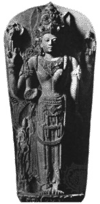|
|
Kertanegara |
ast
king (1268-92) of Tumapel (or Singhasari) in Java,
still venerated among the Javanese as one of their greatest rulers. He united Java,
extended his influence over Sumatra, and resisted Mongol attempts to exact tribute from
his kingdom.
 |
Kertanagara was the
son of princely families--King Vishnuvardhana of Janggala and a princess of Kadiri--so
that by birth he was a reuniter of the two halves of the Javanese kingdom. Even his name,
Kertanagara, meaning "order in the realm," might refer to reunion, which was the
achievement of a great king according to the Javanese dualistic cosmology.Probably for
this reason, he was consecrated a king in 1254 before his father's death. For the ceremony
people from Janggala and Kadiri went to Kutaraja, the capital city of Tumapel,
which was then renamed Singhasari. From that time Tumapel was also called Singhasari.
Kertanagara was too young to rule the country; therefore, his father was still the de
facto ruler. Kertanagara came to power only in 1268. |
Kertanagara's
reign coincided with the expansion of Kublai Khan's realm in
Southeast Asia. Kertanagara thought that he could stop an invasion only by aligning
himself with or conquering neighbouring states and by strengthening himself with religious
rites. His chief minister Raganatha disagreed with Kertanagara's policy and, as a result,
was removed from the post; Aragani, who was an ardent supporter of the policy, therefore
came to power.
Kertanagara
married a princess of Champa (southern Vietnam), a country that was dangerously exposed to
Kublai Khan. Kertanagara sent envoys to Malayu (Sumatra) in 1275, and his statue as
Amoghapasa (Dhyani Buddha Avalokitesvara) was erected in the area
(Jambi) in 1286, an indication that his influence had reached Sumatra. He also conquered
Bali in 1284. A statue of a meditative Buddha, known as Jaka Dolog, discovered in Surabaja
(eastern Java), was also erected by Kertanagara. According to its inscription, the statue
was erected for the benefit of the king, the royal family, and the unity of the kingdom.
Because the statue was erected on the hermitage of Bharada, the great wizard who had been
asked to divide eastern Java into two kingdoms during the reign of Airlangga (1019-49), it
must also have been aimed at neutralizing the evil effects of Bharada's division of his
land.
When an envoy
of Kublai Khan, Meng Ch'i (or Meng K'i), arrived in Java in 1289 to ask for tribute,
Kertanagara refused to pay. This infuriated the Khan, who sent armed forces to punish
Kertanagara. Before the troops arrived, however, Kertanagara was killed by the ruler of
his vassal state, Jayakatwang of Kadiri, in the course of a Tantric ritual drinking
bout. |
| |
|
|
|
|
|
|
|
|
|
|
|
 |
|
 |
 |
 |
 |